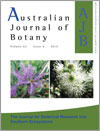Australian Journal of Botany
Volume 62
Number 4 2014
Trampling from recreational trail use can be a threat to plants especially in sensitive alpine communities where effects may persist over time. We re-assessed the impacts of trampling on a rare Windswept Feldmark community following initial sampling 10 years prior and found that trampling continues to cause alterations in species abundance and disrupt shrub succession in addition to broader compositional changes occurring as a result of local climatic trends. It is important to understand that trampling impacts do not often occur independently and management should seek to minimise trampling damage in favour of increasing resilience to larger-scale impacts such as climate change.
This paper reports fecundity and floral morphs from four Australian eastern-coast Melaleuca species, including the vulnerable species M. deanei. Measures reported include fruit and seed loads per plant, fruit set, ovule numbers and seed : ovule ratios under natural conditions. Andromonoecy at low rates is reported for M. deanei and M. thymifolia. Results suggest that significantly lower seed loads per population within the smaller populations of M. deanei reflect a lower seasonal incidence of flowering and lower proportions of flowering plants per population, rather than any limitations in pollination, fruit/seed set or predation.
The paper reports reproductive and structural attributes at the population level for three common species of Melaleuca and from large and small populations of the rare congener Melaeuca deanei. Within relatively smaller populations, M. deanei exhibitted a lower plant density, a lower incidence of flowering, significantly lower proportions of fruiting plants, fewer viable seeds per square metre and limited recruitment.
Information for seed desiccation-sensitivity is crucial for seed conservation of species from the Xishuangbanna tropical rainforest, the greatest biodiversity hotspot in China. Seed-desiccation sensitivity of 101 woody species from the Xishuangbanna tropical forest were analysed using the SCR–SM model. The model successfully predicted seed desiccation-sensitivity of 88% species whose storage behaviour was certain and indicated that ~50% of the species in Xishuangbanna are likely to have desiccation-sensitive seeds.
Monodominance is unexpected in tropical forests, which usually exhibit rich and diverse flora. Hence, monodominant forests raise many questions, and one of the basic issues for managers is to know whether monodominance is a non-persistent step towards mixed forest or a persistent step, which prevents the recovery of a more diverse flora. Here, we present a novel case of monodominance in New Caledonia, with Codia mackeeana (Cunoniaceae) being involved in the secondary succession from anthropogenic savannas toward mixed forest.
Macadamias are native to Australia and are grown worldwide for their edible nuts. However, persistence of their wild relatives is uncertain because of its limited ability to respond to the multiple challenges it faces. Our results provide insight into the patterns and processes that are key to conservation of Macadamia and have wider applicability in conservation of its rainforest habitat.
Myrtaceae, a huge group of flowering plants to which ‘Eucalyptus’ and ‘guava’ belong, forms a major component of tropical rainforests, playing important role in the food chain due to the fleshy fruits eaten by many animals. Myrteae is a subgroup with species difficult to recognise due to the similar flower morphology. The structure of the female part of the flower (gynoecium) revealed great diversity giving new insight on Myrteae evolution, assuring ovule protection and efficient seed dispersal.
Kangaroo paws and catspaws are iconic Australian plants with substantial horticultural potential although they have seed that is often difficult to germinate. Many of these are known to germinate after fire, so the influence of a range of fire-related chemicals on germination was investigated. Once dormancy was alleviated, many kangaroo paw and catspaw taxa germinated in response to glyceronitrile rather than the more widely known smoke-derived chemical, karrikinolide.




